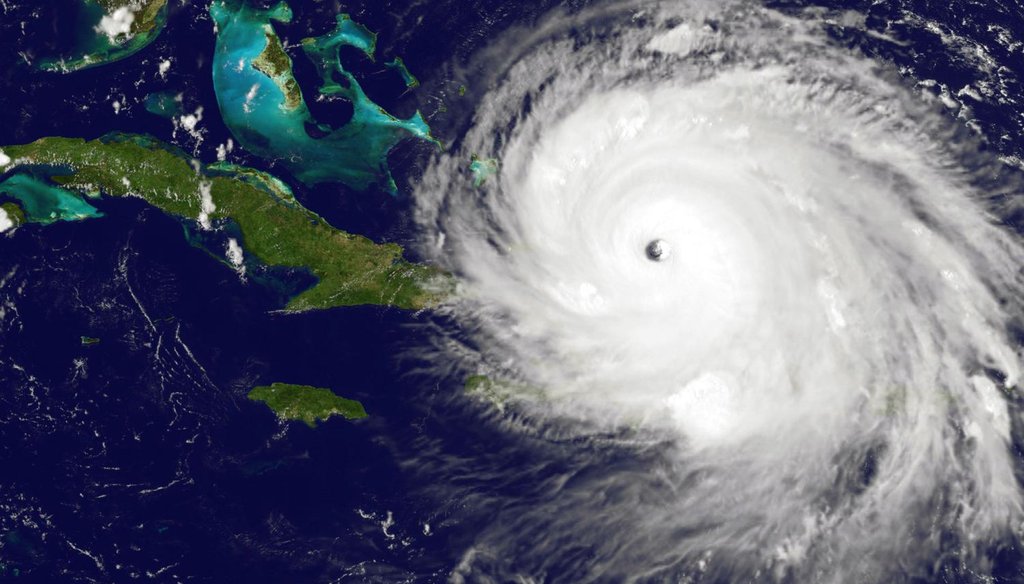

Our only agenda is to publish the truth so you can be an informed participant in democracy.
We need your help.


NOAA's GOES satellite shows Hurricane Irma as it moves towards Florida on Sept. 7, 2017.
• A National Oceanic and Atmospheric Administration report estimates the United States incurred $400 billion in damages from weather and climate disasters from 2015 through April 6, 2018.
• The NOAA calculation includes damage to buildings and public infrastructure, among other costs. The agency tracks damage from drought, flooding, freeze, severe storms, tropical cyclones, wildfires and winter storms.
• Several experts from academia agreed that the NOAA numbers are probably the best available for the United States.
When it comes to weather and climate change, there has been lots of talk about causes and consequences.
In some areas of Wisconsin this winter, rapidly melting snow has overtaken roads and caused sewage to overflow, while flooding and its effects continue to be a concern. The National Weather Service in Green Bay indicated most rivers in northeastern Wisconsin have more than a 50% chance of flooding to some extent.
Whether it be the toll on infrastructure or disrupting business operations, weather and climate change carries a monetary cost.
On Dec. 10, 2019, the U.S. Senate Democrats’ Climate Committee sent out a tweet arguing Wisconsin roads and bridges are at risk of collapse from severe storms and flooding. That same day, U.S. Sen. Tammy Baldwin, D-Wis., tweeted this about the national cost:
"Over the past two years, climate and weather disaster damage has cost the U.S. over $400 billion and our economy will lose over $500 billion annually from lost labor, crop failure and damages related to extreme weather if we don’t #ActOnClimate now."
Is Baldwin right about $400 billion-plus in damages?
The source
When asked for backup for the claim, Baldwin’s staff pointed to The Fourth National Climate Assessment, a 1,526-page document that examines the effects, risks and course of climate change in the United States.
The Fourth National Climate Assessment is a cooperative effort between experts from academia and government agencies, such as the U.S. Department of Energy, the National Oceanic and Atmospheric Administration and the U.S. Department of the Interior.
On page 66, the report indicates NOAA estimates the United States incurred $400 billion in damages from weather and climate disasters from 2015 through April 6, 2018.
But that figure is for different years and a longer time period (three-plus years) than Baldwin claimed.
NOAA climatologist Adam Smith from the Center for Weather and Climate at NOAA’s National Centers for Environmental Information in Asheville, N.C., noted the numbers in the report are also a bit dated. He pointed us to newer figures.
Baldwin’s reference was to the "past two years."
She made the statement in December 2019, so examining the two-year span immediately before that, her numbers are dramatically off. NOAA estimates the U.S. experienced $137.8 billion of economic damage from 2018 and 2019 when adjusted for the consumer price index, and $135.6 billion unadjusted.
However, looking at the two most recent full years before Baldwin’s claim — 2017 and 2018 — Baldwin’s figures line up. NOAA estimates the inflation-adjusted damage in those calendar years was $411.7 billion.
The NOAA calculation includes damage to buildings and public infrastructure, among other costs. The agency tracks damage from drought, flooding, freeze, severe storms, tropical cyclones, wildfires and winter storms.
Smith said in an email NOAA uses data from agencies such as the National Weather Service, the Federal Emergency Management Agency, and the National Interagency Fire Center. There are some types of data they do not include due to inconsistencies.
"For example, our disaster cost estimates are actually somewhat conservative, as we don’t account for losses/damages to natural capital assets, mental and physical healthcare-related costs post-disaster, or incorporate all downstream economic impacts," Smith wrote.
We checked with several experts from academia who agreed that the NOAA numbers are probably the best available for the United States.
The agency’s data shows that the number of disasters that topped $1 billion in damages has increased each decade since the 1980s.
There were 119 weather and climate disasters that topped that threshold during the 2010s, up from 59 in the 2000s, even after adjusting for inflation. Over the past three years (2017 through 2019), there was an average of nearly 15 disasters that topped $1 billion in damages.
Our ruling
Baldwin said "Over the past two years, climate and weather disaster damage has cost the U.S. over $400 billion."
Her claim is on target for 2017 and 2018 -- though if the two years were measured from the date of her claim, essentially covering 2018 and 2019, there was a much-lesser amount in damages.
Our definition of Mostly True is "The statement is accurate but needs clarification or additional information."
That fits here.
Email interview with Adam Smith, NOAA through NOAA’s Office of Communications for Satellites, Jan. 14, 2020
Email interview with Dr. Frances Moore, assistant professor at UC Davis, Jan. 15, 2020
Email interview with Dr. James Rising, research fellow at the London School of Economics, Jan. 21, 2020
National Oceanic and Atmospheric Administration, "Billion-Dollar Weather and Climate Disasters: Summary Stats," 2020.
National Oceanic and Atmospheric Administration, "Billion-Dollar Weather and Climate Disasters: Time Series," 2020.
Adam Smith (National Oceanic and Atmospheric Administration), "2010-2019: A landmark decade of U.S. billion-dollar weather and climate disasters," Jan. 8, 2020.
In a world of wild talk and fake news, help us stand up for the facts.
